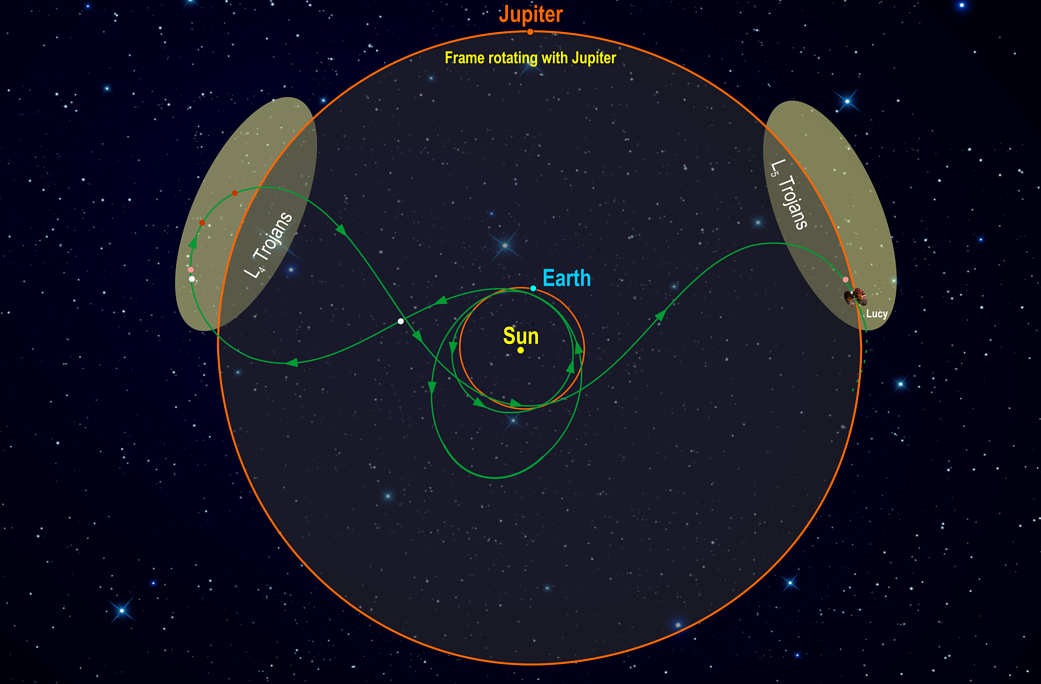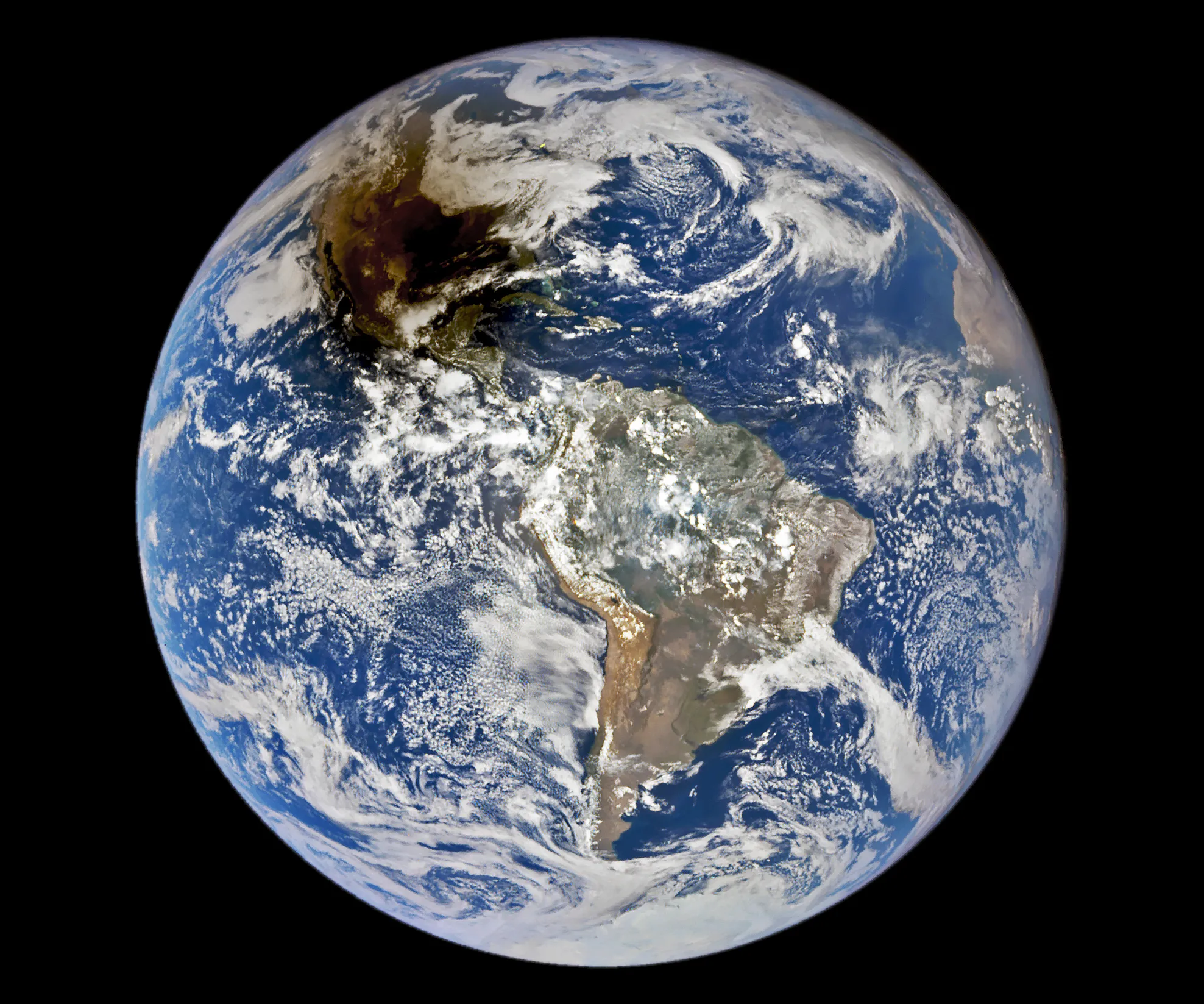Time capsules from the birth of our Solar System more than 4 billion years ago, the swarms of Trojan asteroids associated with Jupiter are thought to be remnants of the primordial material that formed the outer planets. The Trojans orbit the Sun in two loose groups, with one group leading ahead of Jupiter in its path, the other trailing behind. Clustered around the two Lagrange points equidistant from the Sun and Jupiter, the Trojans are stabilized by the Sun and its largest planet in a gravitational balancing act. These primitive bodies hold vital clues to deciphering the history of the solar system, and perhaps even the origins of organic material on Earth.
来自40亿多年前太阳系诞生的时间胶囊,与木星有关的特洛伊群小行星就被认为是构成外行星的原始物质的残余物。特洛伊群小行星以两组松散的方式环绕太阳运行,其中一组在其轨道上领先于木星,另一组紧随其后。特洛伊群小行星围绕着与太阳和木星等距的两个拉格朗日点,在重力平衡作用下被太阳和它最大的行星稳定在一个引力平衡的作用中。这些原始天体为解读太阳系的历史,甚至地球上有机物质的起源提供了重要线索。
NASA’s Lucy will be the first space mission to study the Trojans. The mission takes its name from the fossilized human ancestor (called “Lucy” by her discoverers) whose skeleton provided unique insight into humanity’s evolution. Likewise, the Lucy mission will revolutionize our knowledge of planetary origins and the formation of the solar system.
NASA的露西号将是第一个研究特洛伊群小行星的太空任务。该任务以人类祖先的化石(被发现者称为“露西”)命名,其骨骼为人类的进化提供了独特的见解。同样,露西任务将彻底改变我们对行星起源和太阳系形成的认识。
Lucy is slated to launch in October 2021 and, with boosts from Earth’s gravity, will complete a 12-year journey to eight different asteroids — a Main Belt asteroid and seven Trojans, four of which are members of “two-for-the-price-of-one” binary systems. Lucy’s complex path will take it to both clusters of Trojans and give us our first close-up view of all three major types of bodies in the swarms (so-called C-, P- and D-types).
露西计划于2021年10月发射,在地球引力的推动下,将完成一个12年的旅程,前往8个不同的小行星——一个主带小行星和7个特洛伊,其中4个是“买一送一”双星系统的成员。露西的复杂路径将把它带到两个特洛伊群小行星,让我们第一次近距离观察到小行星群中所有三种主要类型的天体(被称为C型、P型和D型)。
This diagram illustrates Lucy’s orbital path. The spacecraft’s path (green) is shown in a frame of reference where Jupiter remains stationary, giving the trajectory its pretzel-like shape. After launch in October 2021, Lucy has two close Earth flybys before encountering its Trojan targets. In the L4 cloud Lucy will fly by (3548) Eurybates (white) and its satellite, (15094) Polymele (pink), (11351) Leucus (red), and (21900) Orus (red) from 2027-2028. After diving past Earth again Lucy will visit the L5 cloud and encounter the (617) Patroclus-Menoetius binary (pink) in 2033. As a bonus, in 2025 on the way to the L4, Lucy flies by a small Main Belt asteroid, (52246) Donaldjohanson (white), named for the discoverer of the Lucy fossil. After flying by the Patroclus-Menoetius binary in 2033, Lucy will continue cycling between the two Trojan clouds every six years.
这张图显示了露西的轨道路径。航天器的路径(绿色)显示在木星保持静止的参考系中,这使得轨道呈椒盐卷饼状。在2021年10月发射之后,露西在遇到特洛伊小行星群目标之前有两次接近地球的飞行。在L4星群,露西将在2027-2028年飞过(3548)Eurybates(白色)及其卫星,(15094)Polymele(粉色),(11351)Leucus(红色)和(21900)Orus(红色)。在2033年,露西将再次穿越地球,访问L5星群,并访问(617)Patroclus-Menoetius双星(粉红色)。作为奖励,2025年,在前往L4的途中,露西会飞过一颗小的主带小行星——(52246)Donaldjohanson(白色),该小行星以露西化石的发现者命名。2033年飞越Patroclus Menoetius双星后,露西将继续每六年在这两个特洛伊云之间循环运行。
Image Credit: Southwest Research Institute
影像来源:西南研究院



